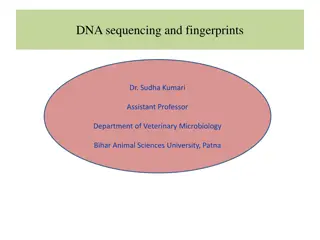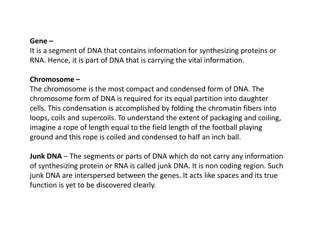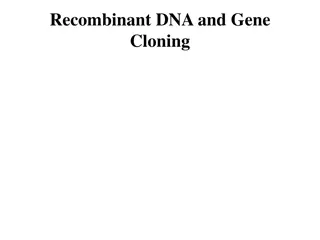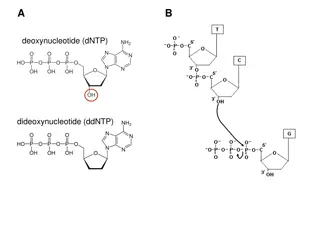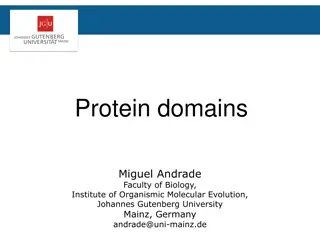Fast Exact Matching Algorithms for Large DNA and Protein Sequences
Searching for specific sequences like "ssi" in "mississippi" can be efficiently done using algorithms like Suffix Trees and Boyer-Moore. These algorithms provide fast searching with low space cost, making them ideal for handling large DNA and protein sequences. While traditional algorithms like Knuth-Morris-Pratt and Boyer-Moore have their own efficiency, Suffix Trees stand out for scenarios where the text is fixed and known first, while patterns vary. The Boyer-Moore algorithm, with its backward matching approach and jumping arrays, offers an optimized method for string matching. Overall, these algorithms play a crucial role in handling complex sequence matching tasks efficiently.
Download Presentation

Please find below an Image/Link to download the presentation.
The content on the website is provided AS IS for your information and personal use only. It may not be sold, licensed, or shared on other websites without obtaining consent from the author.If you encounter any issues during the download, it is possible that the publisher has removed the file from their server.
You are allowed to download the files provided on this website for personal or commercial use, subject to the condition that they are used lawfully. All files are the property of their respective owners.
The content on the website is provided AS IS for your information and personal use only. It may not be sold, licensed, or shared on other websites without obtaining consent from the author.
E N D
Presentation Transcript
Motivation DNA sequences and protein sequences are too large to search by traditional algorithms Text search Need fast searching algorithm(with low space cost) Credit to Brain Chen & Pluto Chang
Exact Matching Problem Find ssi in mississippi
Exact Matching Problem Find ssi in mississippi
Exact Matching Problem Find ssi in mississippi si s
Exact Matching Problem Find ssi in mississippi ssippi si s Every leaf below this point in the tree marks the starting location of ssi in mississippi . (ie. ssissippi and ssippi )
Exact Matching Problem Find sissy in mississippi
Exact Matching Problem Find sissy in mississippi
Exact Matching Problem Find sissy in mississippi s i ss
Exact Matching Problem Find sissy in mississippi s i ss
Exact Matching Problem So what? Knuth-Morris-Pratt and Boyer-Moore both achieve this worst case bound. O(m+n) when the text and pattern are presented together. Suffix trees are much faster when the text is fixed and known first while the patterns vary. O(m) for single time processing the text, then only O(n) for each new pattern.
Boyer-Moore Algorithm For string matching(exact matching problem) Time complexity O(m+n) for worst case and O(n/m) for absense Method: backward matching with 2 jumping arrays(bad character table and good suffix table)
What are suffix arrays and trees? Text indexing data structures not word based allow search for patterns or computation of statistics Important Properties Size Speed of exact matching Space required for construction Time required for construction
Properties of a Suffix Tree Each tree edge is labeled by a substring of S. Each internal node has at least 2 children. Each S(i) has its corresponding labeled path from root to a leaf, for 1 i n . There are n leaves. No edges branching out from the same internal node can start with the same character.
Building the Suffix Tree How do we build a suffix tree? while suffixes remain: add next shortest suffix to the tree
Building the Suffix Tree papua
Building the Suffix Tree papua papua
Building the Suffix Tree papua apua papua
Building the Suffix Tree papua apua p apua ua
Building the Suffix Tree papua apua p apua ua ua
Building the Suffix Tree papua pua a p apua ua ua
Building the Suffix Tree papua pua a p apua ua ua
Building the Suffix Tree How do we build a suffix tree? while suffixes remain: add next shortest suffix to the tree Na ve method - O(m2) (m = text size)
Building the Suffix Tree in O(m) Time In the previous example, we assumed that the tree can be built in O(m) time. Weiner showed original O(m) algorithm (Knuth is claimed to have called it the algorithm of 1973 ) More space efficient algorithm by McCreight in 1976 Simpler on-line algorithm by Ukkonen in 1995
Ukkonens Algorithm Build suffix tree T for string S[1..m] Build the tree in m phases, one for each character. At the end of phase i, we will have tree Ti, which is the tree representing the prefix S[1..i]. In each phase i, we have i extensions, one for each character in the current prefix. At the end of extension j, we will have ensured that S[j..i] is in the tree Ti.
Ukkonens Algorithm 3 possible ways to extend S[j..i] with character i+1. 1. S[j..i] ends at a leaf. Add the character i+1 to the end of the leaf edge. 2. There is a path through S[j..i], but no match for the i+1 character. Split the edge and create a new node if necessary, then add a new leaf with character i+1. 3. There is already a path through S[j..i+1]. Do nothing.
Ukkonens Algorithm In the form just presented, this is an O(m3) time, O(m2) space algorithm. We need a few implementation speed-ups to achieve the O(m) time and O(m) space bounds.











